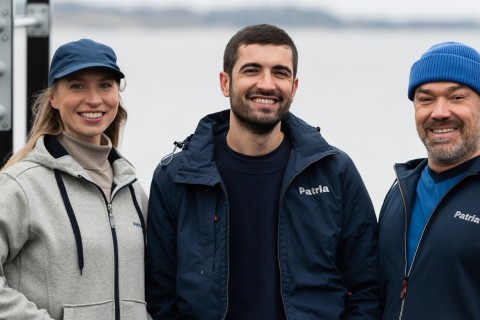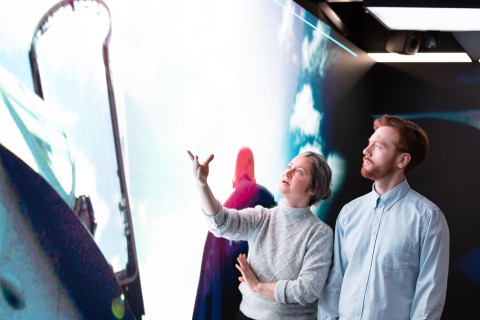

Extending the service life of helicopters
5.12.2016
The service life of two Agusta/Bell 412 EP helicopters of the Finnish Border Guard will be extended by two decades, when Patria modernises the on-board technology to meet modern requirements.
Text: Jukka Nortio
Photos: Ari Heinonen, Lasse Hejdenberg
The commander of the Air Patrol Squadron of the Border Guard, Colonel Antti Pesari, contentedly pats the side of a Bell 412 EP helicopter. This twenty-year old helicopter will be modified at Patria’s Helicopters unit at Arlanda, starting in mid-2017, after the first modernised helicopter is released. Worth three million euros, the contract is scheduled for completion by the end of January 2018.
"The cockpits of the helicopters will be thoroughly renovated and their surveillance and rescue equipment replaced. Once the modernisation project is complete, the helicopters will be ready to operate in Lapland for the next 10 to 15 years," Pesari says.
Comprehensive modernisation
The Border Guard began planning the process of modernising the Agusta/Bell 412 EP helicopters around five years ago. This was sealed by the Border Guard’s purchase of the Super Puma helicopters in 2012. At the time, the decision
Colonel Antti Pesari, The commander of the Air Patrol Squadron of the Border Guard.
was taken to replace the three old Agusta/Bell helicopters operating in Southern Finland with two Super Pumas, and to modernise the two remaining helicopters for the needs of the Rovaniemi base.
"While we initially had an even more extensive retrofit modernisation in mind for these helicopters, we ultimately settled on a more modest and affordable modernisation that we are now implementing," Pesari comments.
"This project is well within our budget and ideal from the technical perspective."
The key objective set for the modernisation project was to extend the service life of legacy helicopters.
"The navigation system also needed to be updated in order to meet the future requirements of instrument flight. Another necessary modernisation was replacing the radio equipment," Pesari says.
"To bring operational missions, such as surveillance and search operations, up to standard, we needed a more efficient infrared camera and light, modern stretchers, as well as other modern rescue equipment. One of the helicopters will also be upgraded with a so called NVG cockpit (Night Vision Goggles), already used in the other helicopter. Furthermore, the tactical computer’s display will be replaced in both helicopters."
The new display will provide better map data on the movements of Border Guard units, facilitating the coordination and management of rescue operations, for example.
The best out of three
The Border Guard selected Patria out of the three shortlisted tenders.
"Patria’s technical solutions are highly successful and selected components are ideal for meeting our needs. We managed to keep the weight under control, at least during the design phase. Although the helicopters will accommodate a lot of new equipment, their total weight will increase by only around twenty kilos," Pesari comments.
Pesari points out that Patria managed to combine the components and technical solutions that best met the needs of both the helicopter type and the Border Guard, creating the optimum overall package.
Another factor worth considering was the previously successful collaboration with Patria’s Helicopters unit at Arlanda.
"We are very familiar with the work done by Patria’s Arlanda unit, having commissioned them to perform helicopter overhauls. They have solid experience of civilian helicopters. On the other hand, Patria has solid experience of project management and design in Finland," says Pesari, by way of clarification.
Moving forwards in collaboration
Scheduled to last a couple of years, the helicopter upgrade project requires close collaboration between all parties, as surprises always occur despite the best-laid plans.
"We established a good rapport with Patria as early as the negotiation and planning stage. The project benefited from the fact that we could allocate a sufficiently long period for negotiations, enabling us to review a high number of project-related details," Pesari says.
The first helicopter was delivered to Patria for modernisation as soon as the contract on collaboration was signed, in early September. The final decisions on details of the design plans will be taken as the work progresses.
"We will provide feedback at every stage of the work, giving our viewpoint on progress. By the time the helicopter is almost finished in production, we will be closely involved with its testing," Pesari comments.
Although both parties are prepared to fine-tune the plans during the work, Pesari praises Patria for the precision of its pre-design.
"All the preliminary technical plans and schedules were completed, which helped us commit to this project."
Pesari uses three criteria to evaluate the success of the overall helicopter modernisation project.
"The schedule was a highly critical issue for us. We wanted a plan for returning the helicopters to operational use, as we had no spare rotorcraft. Another issue was cost management; we wanted to be able to monitor expenses throughout the project. The third issue is the quality of the work, which is an absolutely key criterion in aviation."
What did you like about the article?
Thank you for your opinion! You can share the article on social media using the buttons below:























